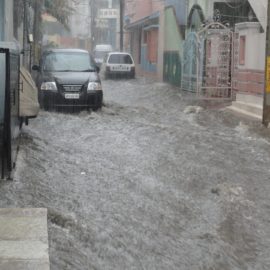
The Comite River Diversion seems to be slipping away.
The timeline for the Comite River Diversion Canal — the Baton Rouge region’s biggest flood control project for the past two generations — continues to slip as state highway and federal officials indicated Tuesday the nearly $500 million canal is probably more than two years from completion. The 12-mile-long diversion, however, which has been under construction since 2019, has hit several milestones, as more than half the canal has been dug, three of seven new bridges are nearly finished, two of three bayou diversions into the new waterway are under construction and almost all of the land has been bought. A state legislative panel tracking the canal’s progress also learned Tuesday that significant relocations for two Florida Gas Transmission pipelines could start construction as soon as August, if a key regulatory hurdle is cleared in the coming months. The U.S. Army Corps of Engineers and the Louisiana Department of Transportation and Development are sharing in different pieces of the construction job. Amid pressure from legislators and the public worried about the next hurricane season, Col. Cullen Jones, district engineer for the Corps of Engineers in New Orleans, told the panel that “the desire for urgency is not lost on the Corps and the Department of Transportation.”
nola.com
The diversion will move a lot of water from flooding to the Mississippi.
Compared to a manmade river, the waterway, Corps officials say, will have the ability to divert the equivalent of a full Arkansas River to the Mississippi River once built, reducing flooding across the region but most significantly in the Baker and Zachary area. Talked about since the 1960s, the diversion canal took conceptual form after the historic 1983 flood. It will cut almost due west across northern East Baton Rouge Parish, intercepting highways, bridges, railroads and swamps on an 8-mile path to a local bayou that will carry the water the rest of the way to Mississippi. Early last year, officials learned the Florida Gas pipeline relocations — two of more than 60 utility relocations needed — would pose a new delay for the long-sought canal that gained new momentum and funding after the 2016 flood. The two pipelines are in the path of the planned canal and bridge construction at La. 19, effectively blocking that work until they are moved. The lines cut diagonally through a long section of the 300 foot-wide, 50-foot-deep canal route. With those gas lines moved, Christina Brignac, a state highway engineer, indicated on Tuesday that her agency’s piece of the construction could be finished by mid-2025.
The Corps hopes that their part will be finished in under two years.
Jones, Corps district engineer, suggested that agency’s piece of the construction could be finished between the last quarter of 2024 and third quarter of 2025. Brignac held out hope the recently finished design for the pipeline relocations could allow the Corps and Florida Gas to work on the relocation and final canal digging at the same time, potentially cutting time. The section of canal delayed by the pipelines is expected to take a year to construct. Mike Futch, a vice president with Energy Transfer Partners, which has a 50% stake in the Florida Gas pipelines, told the legislative panel that with the final design and Corps approval close, he expects the company to make its application to the Federal Energy Regulatory Commission in May. The FERC process could take 90 days to complete if it faces no major objections and isn’t routed to a more-extensive regulatory review.
This has not been a smooth process.
Through the diversion’s history, the project has hit a variety of slowdowns: political, regulatory but most often financial, until Congressman Garret Graves, R-Baton Rouge, got it fully funded in 2018. Local residents contributed property tax revenue to the project for 20 years, though the tax has ended. State Rep. Valarie Hodges, R-Denham Springs, chairwoman of the panel overseeing the canal, picked up on the comments of some residents who spoke at the hearing Tuesday and had advocated for more urgency and foresight from the Corps and DOTD. Some aired concerns about a possible delay from the very last piece of the canal, construction of the diversion structure, which will pull water from the Comite River and shunt it into the canal. “And so they echo what we feel so strongly. And, … I know the thing with the Florida Gas line took an extra eight months, and, before that, it was the railroad, and these unforeseen things and so our fear is it’s going to be more unforeseen things and we’re still looking at, you know, two to three more years,” Hodges said. “What more can you guys do? I’m not trying to put you guys on the spot. I’m just trying to … we need to think outside the box,” she added.
The Corps responded hoping things can smooth down now.
Two Corps of Engineers officials working on the canal offered a mixed answer. On the one hand, they suggested that perhaps the biggest hurdles had been cleared and, on the other hand, acknowledged they can’t predict the unforeseen but can try to anticipate choke points. “There’s been a lot of unforeseen things that have come up, and to sit here and think that we’ve had the last unforeseen issue is naive. There’s going to be more issues that pop up,” said Bobby Duplantier, Corps project manager for the canal project. Duplantier said that, for instance, in light of recent supply chain problems nationally, the Corps of Engineers has encouraged contractors to buy all their supplies at once so a later bottleneck doesn’t delay work. Under earlier questioning from Paul Sawyer, a top aide to Congressman Graves, Corps officials also indicated they are still working on an updated cost estimate for the canal construction in light of rising construction and labor costs.
No project is easy but this one seems to have hit many problems.



